Combine developments deliver more power
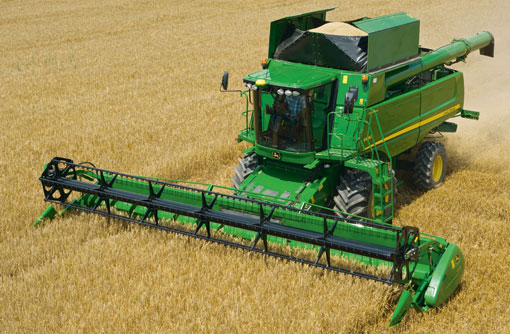
A revised threshing and separation rotor is at the heart of a new John Deere S-Series line-up of full-rotary combines that has been extended from just a single model to three in an effort to capture a larger slice of the top-end harvester market.
The range-leading S690’s 625hp peak engine output for on-the-move unloading sets a new record for combines and its 14,100-litre grain tank easily out-sizes competitor machines. Also, it can be equipped with Deere’s own track system for the first time.
Grain tank
Next is the S680, which packs a 507hp motor and the same extra-large grain tank as on the S690, while the S670 comes with a 398hp engine and 10,600-litre grain tank.
To underscore the extent to which the design has been revamped and made more suited to UK conditions, product manager Mark Smith points out that of the 45% new parts in the machines, 85% are focused on improving performance in small grain crops such as wheat and barley.
“Together with the $100m investment put into the development of these combines, this shows the seriousness of our intent to meet the needs of large growers better than before,” he adds.
That programme has brought in new engines and a larger cleaning area to match the improved performance potential of the revamped threshing and separation rotor.
But for all the performance gains these improvements and refinements bring, operators will be keen to check out the new Premium cab, which has almost a third larger interior volume and more storage facilities than the current design.
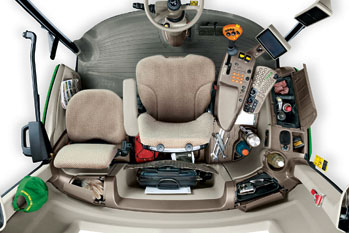
A seat-mounted console brings all controls into one place and is modelled on the CommandArm used on larger John Deere tractors. Visibility to the cutting table is said to be improved thanks to the larger glass area and slimmer pillars, and at night with improved external lighting.
The new cab is also being introduced across the T Series straw walker combines, which otherwise continue largely unchanged apart from Stage 3B emissions-compliant engines and a new push-button transmission shared with the S670 that does away with a lever for selecting ranges.
Deere’s more sophisticated ProDrive hydrostatic transmission is installed on the higher performance S680 and S690, featuring
automatic shifting between two speed ranges and an electrically-activated diff lock. Both transmission types work in concert with the PowerTech PSX six-cylinder engine first seen in Deere’s latest-spec 8R Series tractors.
Additional power
In the range-leading S690, normal harvesting output is 580hp Ð 50hp up on the previous version. But additional power is available on all models temporarily when unloading the grain tank on the move.
In-field performance of the new-look combines is influenced by changes to the Variable Stream Rotor. It works in the same way as the previous design, but has been refined to improve grain threshing and separation performance in oats, barley and wheat crops, while being less harsh with the straw.
“The threshing section at the front of the rotor is now tapered to allow the crop to expand and there is also a short tapered section at the end of the rotor to help straw pass from the rotor to the overshot beater at the outlet,” explains Mr Smith. “Vanes on the upper housing can be set in one of two pitch angles so that crop flow can be adjusted according to conditions Ð when dry and brittle, for example, the crop is encouraged to flow through the system faster.”
Furthermore, tailings are now handled separately through a re-thresher rather than adding to the rotor’s workload.
Radical changes and host of upgrades for MF offering
A parallel linkage wheel hub mounting for the drive axle of Massey Ferguson Beta combines is one of the more radical changes among a host of upgrades and new developments across the MF harvester range.
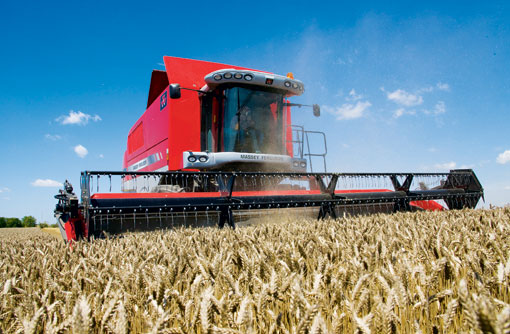
Others include increased power and cleaning system changes for the Centora models that give them greater output potential; increased grain tank capacity and the option to fit a PowerFlow table to the Activa “S” models; and more comprehensive electronic driver assistance in the cab for both Activa and Beta combine drivers.
It all adds up to a pretty comprehensive revamping of the MF range, which comes in the wake of last year’s full acquisition of the Laverda business in Italy where all Massey Ferguson combines for Europe are now built.
This includes the range-topping 9280 Delta, the sole “hybrid” combine in the line-up featuring conventional threshing technology with twin rotor separation.
Commercial debut
Having its European commercial debut this year, “it’s produced good output in a variety of crops, with excellent samples and low losses,” MF product manager Adam Sherriff says. “It should appeal to larger operators wanting more output and flexibility.”
Meanwhile, more performance is being extracted from the conventional Centora design, which retains its unique eight-walker separation system.
“For next season, the Centora gets increased performance potential from a revised threshing concave and cleaning system, and increased engine power and torque,” says Mr Sherriff.
In the cleaning department, throughput potential is raised by increasing the angle of the grain preparation pan and extending its oscillation stroke to deliver grain faster on to the grain pan. The grain pan itself is also inclined more steeply and has a more aggressive shaking motion to speed up transportation of grain from the concave to the cascade cleaning system.
At the front end, the threshing cylinder concave can now be opened wider when appropriate – to a maximum of 40mm – to take a bigger volume of crop.
“A wide concave setting not only allows more crop to flow through but in easily threshed crops, such as oilseed rape, it also helps cut power requirement and therefore fuel consumption,” says Mr Sherriff.
Second-generation exhaust clean-up technology makes its appearance in the engine bay where the SCR-equipped AGCO Sisu Power 8.4-litre six-cylinder motor is said to be more economical, despite delivering higher power output.
For the MF 7280 Centora, power climbs by 31hp or 9% to peak at 379hp for harvesting, with an extra 25hp available when the grain unloading auger is switched on at the same time. A 21hp or 5.5% power hike for the MF 7282 Centora takes its full-time peak output to 404hp.
Smooth and consistent power delivery is said to be guaranteed thanks to the new Engine Drive plate developed for the Delta’s seven-cylinder diesel and now installed on the six-cylinder motor. It buffers the power unit and driveline from shock loads to increase durability over the lifetime of the combine.
At the other end of the performance scale, the five-walker MF 7244 Activa now has an AGCO Sisu engine of the same power as the Fiat Powertrain unit employed previously, and the two newcomers replace the 7245, 7245 S and 7246.
A new cab, increased grain tank capacity, higher power output for the six-walker machine and the option of using the higher-performance PowerFlow cutting table are the main changes here.
Clean-up technology
On the higher-spec Beta combines, auto levelling to provide slope compensation has switched from a rotating spur gear final drive unit on both ends of the drive axle to a parallel linkage assembly.
“The key advantage of this compact design is that wider tyres can be fitted without pushing overall width beyond 3.5m,” says Mr Sherriff.
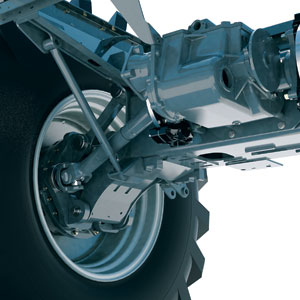
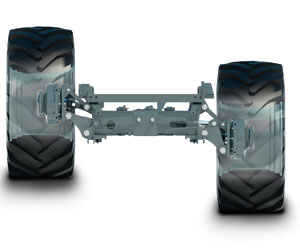
A telescopic drive shaft connecting the centrally-mounted gearbox to the new 10-bolt hub is positioned alongside the parallel linkage to allow it sufficient movement to compensate for side slopes up to 20%.
Formed by a fabricated arm at the bottom and a slim upper link, the linkage automatically lowers the combine to drop the centre of gravity for maximum stability and draw the wheels in to the narrowest track width for road travel, when the combine can run at up to 26kph.

